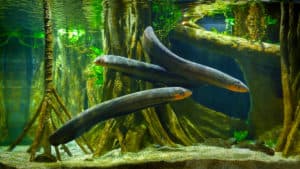The moray eel is an unusual and fascinating creature – but then, so are octopuses! So, we are very lucky to see an interaction between the two of them. Perhaps the eel has attempted to attack the octopus, viewing them as prospective prey? However, the octopus has other ideas. They manage to clamber aboard the eel and ride like they are in a rodeo! Meanwhile, the moray eel swings from side to side and attempts to dislodge the determined octopus. Eventually, the octopus lets go and races away – but not before inking towards the moray to hide their escape route!
Moray Eels Hunting
Moray eels spend a lot of time in holes in reefs in tropical and temperate ocean waters but do need to hunt to get food. They are carnivores and the larger individuals will be the apex predators in some habitats. In other areas, they get eaten by sharks, sea snakes, and barracudas. They hunt by hiding in the reef and then lunging at unsuspecting prey. This is mainly fish but they will also attack crustaceans and, as we see here, octopuses – although that does not always go well! Some morays have long, canine teeth but others have blunt teeth that are better for crushing up crabs. A key trait is to tie themselves in a knot to anchor themselves whilst they are tearing at the flesh of the prey.

Moray eels spend a lot of time in holes in reefs in tropical and temperate
ocean
waters but do need to hunt to get food.
Octopuses and Their Defense
Octopuses are found in oceans all over the world. They like to live in coastal waters and, like morays, they spend a lot of time in dens which are usually small crevices in rocks or coral. These fascinating animals have a number of defense mechanisms to help protect them from their predators which include seals, sperm whales, sea otters, some birds, and, as we see here, moray eels.
Firstly, they can hide very effectively! They spend a lot of time in crevices leading a solitary life where they cannot be seen. Secondly, they are masters of disguise. They can change color rapidly to blend in with their surroundings. Finally, as we see this clever octopus doing, they can eject ink which both startles and confuses the predator and allows them to make a speedy escape!
The photo featured at the top of this post is © Andrea Izzotti/Shutterstock.com
Thank you for reading! Have some feedback for us? Contact the AZ Animals editorial team.





